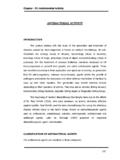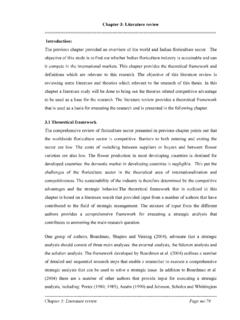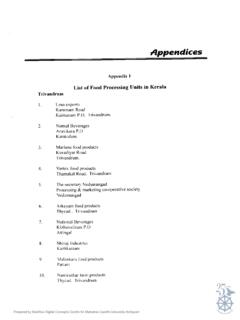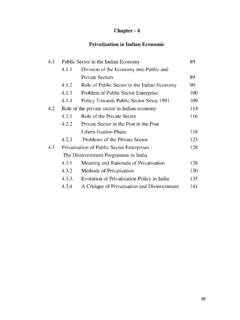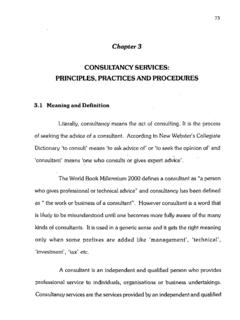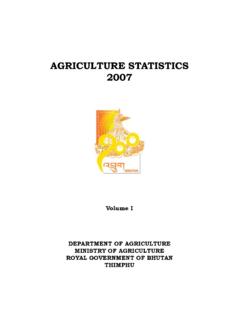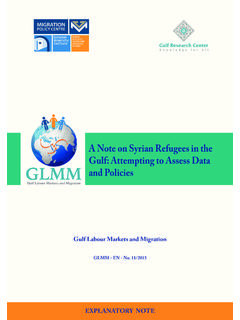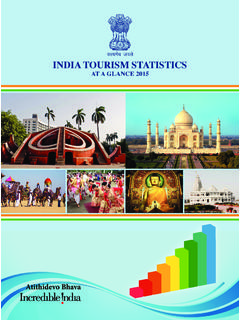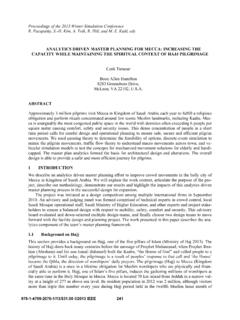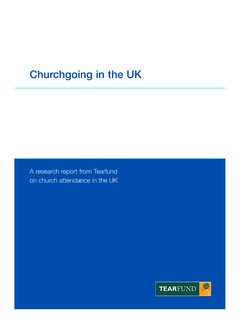Transcription of TOURISM - AN OVERVIEW - Shodhganga
1 Chapter III TOURISM - AN OVERVIEW This chapter deals with the economic perspectives of TOURISM , unique features of tourists, TOURISM destinations of Kerala and Tamil Nadu and the emerging concepts of TOURISM . Introduction TOURISM is the world s largest industry with an annual revenue of almost $550 billion1. TOURISM industry has earned over $735 billion worldwide, generated over 842 million international travellers in the year 2006 and number of tourists has increased to 898 million in 2007(as per WTO records). Domestic TOURISM also has been increased upto atleast 9000 million worldwide. According to World TOURISM Institute and World TOURISM and travel Corporation (vision 2020) the prediction for TOURISM is that till 2020, the number of tourist traveling across the world will be nearly 1600 million and they will spend nearly $2000 billion on it.
2 The average growth in TOURISM industry will be nearly and the receipts will be of the total receipts2. TOURISM involves basically three elements namely man (human element as the creator of the act of TOURISM ), space(the physical element to be necessarily covered by the act itself), time(the temporal element which is compared by the trip itself and the stay at the destination). TOURISM is defined as the sum of the phenomenon and relationships arising from the travel and stay of nonresidents in so far as they do not lead to permanent residents and they are not connected with an earning activity. TOURISM is an industry which is capable of providing economic growth in income and standard of living. TOURISM with multi-dimensional activity has evolved as one of the largest and lucrative industries of the new millennium. It is therefore worthwhile to examine India s position in the world TOURISM map.
3 Despite varied and rich cultural 39 heritage, compared with the rest of the countries, India s share in world TOURISM has been reported to be dismal. India is the seventh largest country in the world covering an area of lakh which accounts nearly 2% of the world s total land surface. It has got 6100 kms of coastal line and 15168 kms of land frontier. It is bounded on the south-west by the Arabian sea and on the south-east by the Bay of Bengal3. India s amazing diversity offers everything for everyone that they would like to have for a holiday. The moment a person sets foot in India, he is greeted by a graceful namaste, a gesture that denotes both welcome and respect. India is a land of contrasts. The vast snow-covered Himalayas, fertile Gangetic plain, Great and little desert regions, virgin and verdant rain forests, spectacular beaches, backwaters coastal areas etc adds the mesmerizing physical diversity of India.
4 But the success of the TOURISM sector is highly influenced by the supporting industries such as hotels, transportation, communication, banking and so on. The vast civilisational heritage of our country ranging from Himalayas to Kanyakumari has a lot to attract tourists. Considering the size, population and resource, India is way below its justified position. According to WTTC, India will rank sixth worldwide in terms of real growth of international tourists spend in the forthcoming decade (2006 to 2015) and Indian TOURISM is expected to grow at an impressive for the same period. Further, WTO has estimated that there will be billion international tourists by the year 2020 and Asia will emerge as the second region to be the most visited in the world. The contribution from services sector today stands over 45% of the total GDP in India.
5 The sector currently employs close to 22 million people in India4. India s earnings from TOURISM increased to $ billion in the year 20075. The average growth rate for TOURISM industry in India is 13% as compared to growth rate in the world as 7%. TOURISM industry in India has to its share of of 40 world TOURISM and the receipts as of the world receipts. The Indian TOURISM industry has earned over $735 billion generated worldwide over 842 million international travelers in the year 2006 and the number of tourists has increased to 898 million in 2007(WTO)6. Domestic TOURISM has also increased up to 9000 million worldwide. India s TOURISM sector is projected to grow at per cent ahead of China over next 10 years7. According to WTTC, capital investment in Indian TOURISM sector is expected to touch the $ billion mark in 20148. India being rich in cultural heritage is likely to experience its share in global TOURISM .
6 India, however, faces two challenges in the global world that is exploitation of TOURISM potential and designing strategies from tapping such potential. But it is to be noted that TOURISM in India during last 50 years has shown tremendous progress. From a beginning of 17000 international tourists in 1950 contributing crore to the economy the present arrival of million tourists contributing about $ billion in foreign exchange earnings and the number of domestic tourists has swelled to a massive 200 million is really a substantial progress. TOURISM industry being labour intensive has potential to solve the problem of unemployment and reducing poverty. Moreover, TOURISM is most effective instrument for national integration, harmony and thus leading towards social transformation and upliftment of rural poor. Domestic TOURISM is generally thought to be upto five times that of international arrivals.
7 The major highlights of Indian TOURISM are the following: Helping to preserve and retain our rich cultural heritage Giving more innovative promotional measures for TOURISM Increase in international trade Progress in healthcare industries Increase in GDP making TOURISM industry a unifying force Growth in hotel industry Focus on rural TOURISM Advancement with sophisticated communication network 41 Enriching peripheral services like developing websites for Indian TOURISM and offering hotel, hospitality, booking tickets online etc The concept of TOURISM is so complex to define though several attempts have been made by renowned writers to explain it. The International Dictionary of TOURISM points out that tour in English and in French means journey, a circulative trip9. The nineteenth century dictionary defines tourist as people who travel for pleasure of traveling, out of curiosity and because they have nothing better to do and even for the joy of boasting about it afterwards.
8 The International Union of Official Travel Organisation (IUOTO), now called World TOURISM Organisation (WTO) has defined tourist as a temporary visitor staying for atleast twenty four hours in a country. The purpose of the journey can be classified under one of the following headings: (a) leisure-recreation, holiday, health, study, religion and sports (b) business, family, mission meetings etc. Economic Perspectives The economic benefits from TOURISM can be assessed considering the flow of foreign tourist arrivals, domestic tourist arrivals, earnings from TOURISM for various years and plan allocation for TOURISM in Kerala and Tamil Nadu. Kerala In the year 2000, the number of foreign tourist arrivals in India were 2649378 whereas in 2009 it was 5108579. In the year 2000, the number of foreign tourist arrivals to Kerala were 2,09,933 whereas in 2009 it was 5,57,258.
9 The foreign tourist arrivals to Kerala has been remarkable as seen in the figures in table :- 42 Table No. Foreign Tourists Arrival in Kerala and India Year India ( ) Kerala ( ) Kerala s Share (%)in Country s TOURISM 2000 26,49,378 2,09,933 2001 25,37,282 2,08,830 2002 23,84,364 2,32,564 2003 27,26,214 2,94,621 2004 34,57,477 3,45,546 2005 39,18,610 3,46,499 2006 44,47,167 4,28,534 2007 50,81,504 5,15,808 2008 52,82,603 5,98,929 2009 51,08,579 (P) 5,57,258 Source: India TOURISM statistics 2006, Ministry of TOURISM , Government of India, Tourist Statistics2000-2010, Department of TOURISM , Government of Kerala, Economic Review 2000-2010,Government of Kerala P - Provisional 43 shows the WTTC s current and projected impact of the travel and TOURISM industry on employment at an industry and economy level, at a global level, for India and for Kerala.
10 Clearly, travel and TOURISM at both the industry and economy level is expected to be a major contributor for future employment growth in Kerala, well above the Indian and international average. Over the next 10 years, Kerala s travel industry is expected to create 757,100 new jobs, while the broader impact of the travel economy will create million new jobs. Table No. Employment Impact of Travel and TOURISM in the World, India and Kerala Particulars 2003 2013 000 Jobs Share Y-on-Y 000 Jobs Share CAGR Growth7 Growth8 World T & T Industry Employment T & T Economy Employment 194562 24720 India T & T Industry Employment 1 T & T Economy Employment 6 Kerala T & T Industry Employment 3 T & T Economy Employment 15 Source: WTTC Report, Kerala s Approach to TOURISM Development: A Case Study Ministry of TOURISM & Culture, Government of India 44 The trend in the arrival of domestic and foreign tourists arrivals to Kerala reveals that there has been a corresponding increase in the growth of both domestic tourists and foreign tourists arrival from 2000 to 2009.
